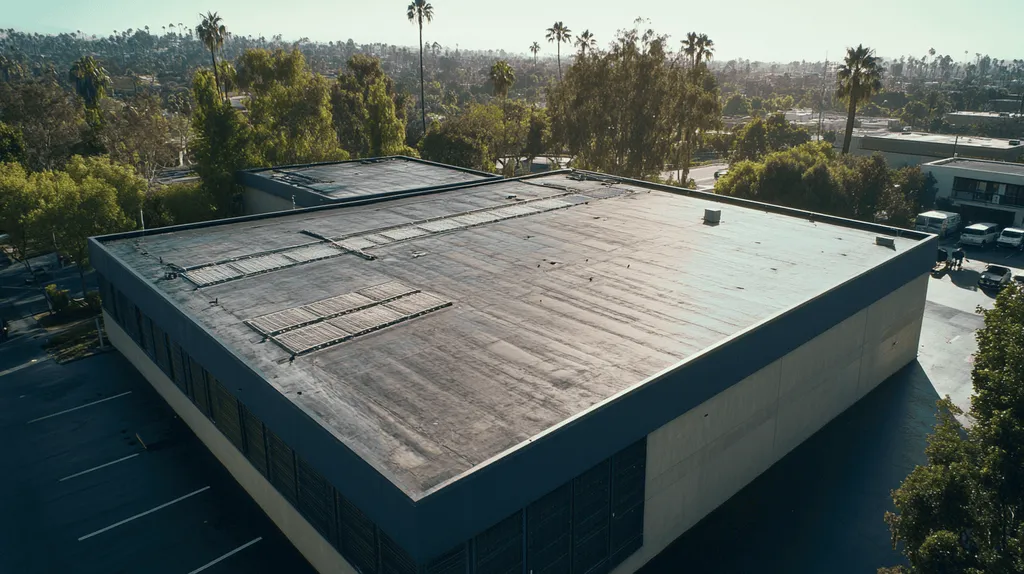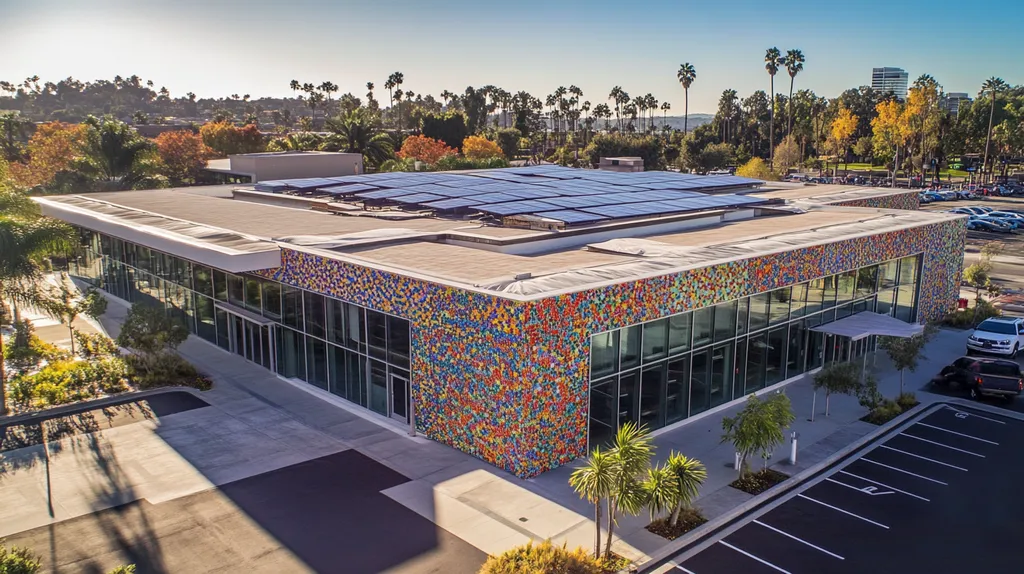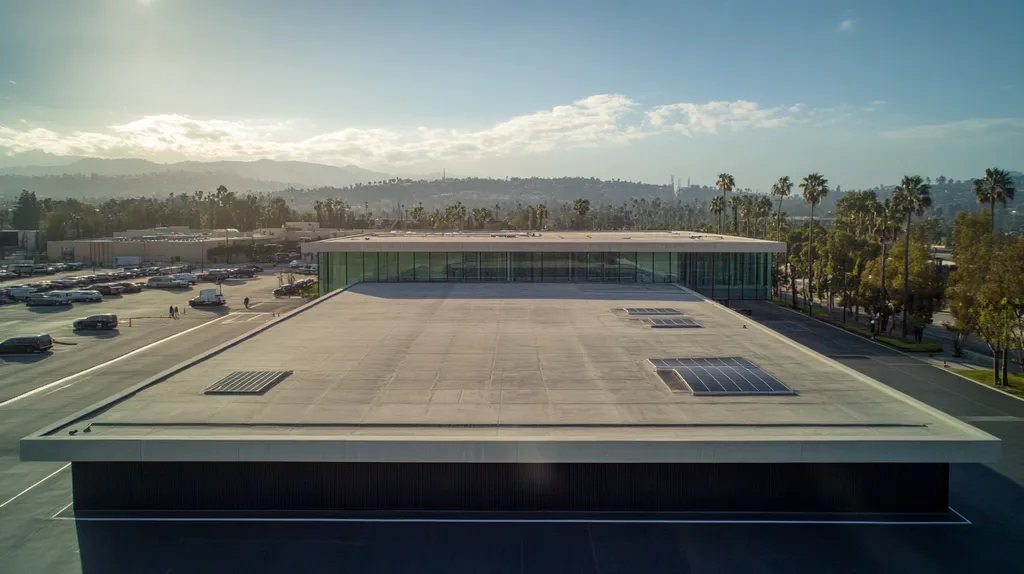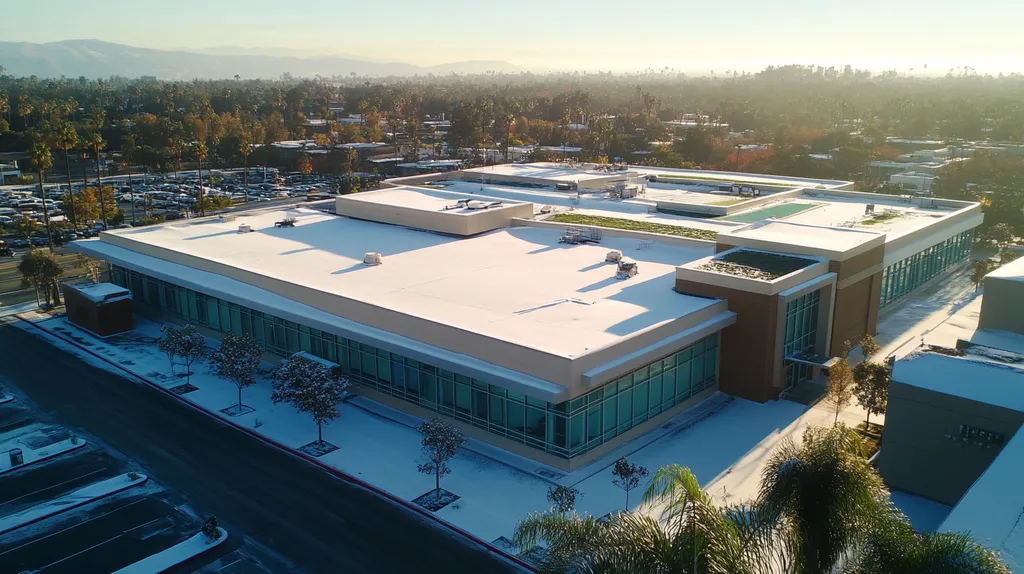Winter-related roof failures cost U.S. businesses over $1 billion annually in repairs, inventory damage, and operational disruptions. Recent industry studies show that 73% of these failures stem from improper material selection.
As commercial buildings face increasingly extreme winter conditions, choosing the right roofing materials has become critical for long-term structural integrity and business continuity.
This comprehensive guide examines the essential components, implementation methods, and performance metrics that determine a commercial roof’s ability to withstand winter’s harshest challenges, from freeze-thaw cycles to heavy snow loads.
SECTION 1: FUNDAMENTAL CONCEPTS
Winter presents unique challenges for commercial roofing systems, with material selection becoming increasingly critical as temperatures drop. Statistics show that winter-related roof failures can cost businesses millions in repairs, inventory damage, and operational disruptions. Understanding the fundamental concepts behind winter roofing performance helps facility managers make informed decisions that protect their investments and ensure business continuity.
Freeze-Thaw Cycle Impact on Roofing Materials
The freeze-thaw cycle represents one of winter’s most destructive forces on commercial roofing systems. When water penetrates microscopic cracks in roofing materials, it expands by approximately 9% upon freezing, creating powerful destructive forces.
Traditional single-ply membranes can become particularly vulnerable during these cycles. The repeated expansion and contraction create micro-fractures that compound over time, eventually leading to material failure.
Modern composite materials specifically engineered for freeze-thaw resistance incorporate flexible polymers that maintain their integrity even after hundreds of cycles. These advanced materials can absorb the stress without compromising their protective properties.
Regular inspections during freeze-thaw periods should focus on areas where different materials meet, as these transition points often show the first signs of stress.
Thermal Expansion and Contraction Effects
Proper insulation plays a crucial role in moderating temperature fluctuations that stress roofing materials. Well-designed insulation systems not only improve energy efficiency but also help prevent ice dam formation and manage condensation. (source: Aquila Commercial)
Different roofing materials exhibit varying coefficients of thermal expansion. Metal components can move up to 1 inch per 100 feet with a 100°F temperature change, while polymer-based materials show more stability.
Strategic placement of expansion joints and proper fastening systems allows materials to move naturally without compromising the roof’s integrity. These mechanical solutions must account for both daily and seasonal temperature variations.
Modern building management systems can help monitor roof temperatures and movement patterns, allowing facility managers to anticipate potential stress points before they become problematic.
Winter Weather Hazards Specific to US Regions
Regional winter challenges require tailored roofing solutions. The Northeast faces heavy snow loads and ice damming, while the Midwest must contend with extreme temperature swings and high winds.
Coastal regions experience salt spray and maritime conditions that can accelerate material degradation. These areas require specially formulated coatings and corrosion-resistant components.
Mountain regions face unique challenges with rapid temperature changes and intense UV exposure. Roofing systems in these areas must incorporate materials that maintain flexibility while resisting sun damage.
The Southwest, though warmer, still requires winter-specific considerations for occasional freezing temperatures and seasonal rains. These systems must balance thermal protection with excellent drainage capabilities.
Understanding local climate patterns helps facility managers select materials that provide optimal performance for their specific regional challenges.
SECTION 2: SYSTEM COMPONENTS
Winter performance demands specialized roofing components that work together as an integrated system. Industry data shows that 65% of winter-related roof failures stem from using components not rated for extreme cold. Each element must maintain its integrity under snow loads, freeze-thaw cycles, and brutal temperature swings that can stress materials beyond their limits.
Roofing Membranes Best for Cold Climates
Modern winter-rated membranes incorporate advanced polymer technology that maintains flexibility even at subzero temperatures. TPO and EPDM membranes lead the market for cold-weather performance, with specially formulated compounds that resist brittleness and cracking.
Multi-ply modified bitumen systems offer exceptional durability through reinforced layers that distribute stress from snow loads and thermal movement. These systems typically include a glass-fiber mat or polyester core that enhances tear resistance and dimensional stability.
PVC membranes excel in regions with frequent freeze-thaw cycles due to their superior chemical resistance and weldable seams. The hot-air welded seams create monolithic surfaces that eliminate vulnerable mechanical fasteners.
Membrane thickness plays a crucial role in winter performance, with 60-mil or greater recommended for maximum puncture resistance and durability under ice conditions.
Flashing and Sealants Resistant to Ice and Wind
Critical transition points require winter-specific flashing materials that maintain flexibility while resisting moisture infiltration. Reinforced liquid-applied flashings provide seamless protection around penetrations and complex geometries.
Cold-weather sealants must maintain adhesion and elasticity across extreme temperature ranges. Modern polyurethane and silicone formulations offer 300% elongation capacity while resisting UV degradation.
Metal flashing components demand careful material selection, with aluminum and stainless steel preferred for their superior corrosion resistance. These materials must incorporate expansion joints every 40 feet to prevent buckling under thermal stress.
Installation techniques become especially critical for winter performance, requiring clean, dry surfaces and temperature-appropriate application methods to ensure proper adhesion.
Insulation and Ventilation to Prevent Condensation and Ice Dams
Proper insulation and ventilation work together as a system to prevent destructive ice dam formation. Maintaining consistent roof temperatures through adequate insulation prevents the freeze-thaw cycles that lead to ice accumulation.
Strategic placement of ventilation channels helps regulate temperature differentials between interior and exterior surfaces. This balanced approach minimizes condensation risks while promoting energy efficiency.
Multi-layer insulation systems with staggered joints prevent thermal bridging that can create cold spots. These vulnerable areas often become nucleation points for ice formation and subsequent water damage.
Proper insulation plays a crucial role in moderating temperature fluctuations that stress roofing materials, while ventilation helps prevent ice dam formation by maintaining consistent temperatures. (source: Aquila Commercial)
SECTION 3: IMPLEMENTATION METHODS
Winter implementation demands precision in both planning and execution, with statistics showing that 70% of cold-weather roof failures stem from improper installation methods. Each phase of winter roofing work requires specialized techniques and materials that differ significantly from warm-weather practices. From adhesive selection to structural reinforcement, the consequences of inadequate winter implementation can lead to catastrophic failures costing businesses millions in repairs and downtime.
Winter Installation Challenges and Adhesive Selection
Cold-weather installations require specialized adhesives that maintain bond strength at temperatures as low as 20°F. Standard adhesives become ineffective below 40°F, leading to immediate failure or delayed delamination months later.
Material storage and conditioning become critical factors in winter installations. All adhesives and membranes must be kept above 50°F for at least 24 hours before application to ensure proper performance.
Advanced winter-grade adhesives featuring dual-component technology provide reliable bonds even in challenging conditions. These formulations achieve full cure strength in half the time of conventional adhesives while maintaining flexibility.
Installation teams must closely monitor surface temperatures and moisture levels throughout the application process. Even brief exposure to frost or condensation can compromise adhesion and void manufacturer warranties.
Best Practices for Snow and Ice Load Management
Proper insulation and ventilation work together as a system to prevent destructive ice dam formation and manage snow loads effectively. Strategic placement of snow guards helps control accumulation patterns and prevent dangerous snow slides.
Installing heating cables along roof edges and in valleys provides active protection against ice dam formation. These systems, when properly designed, can reduce winter maintenance costs by up to 40%.
Regular monitoring and documentation of snow depths helps facility managers anticipate potential overload conditions. Critical thresholds vary by roof design but typically range from 20-30 pounds per square foot.
Professional snow removal services should follow precise protocols to prevent membrane damage. Using proper tools and maintaining safe clearance zones above the roof surface ensures protection of the underlying system.
Structural Reinforcement Techniques for Snow-Prone Roofs
Structural reinforcement begins with comprehensive load analysis that accounts for both dead loads and anticipated snow accumulation. Modern engineering software can model stress patterns and identify vulnerable areas requiring additional support.
Installing additional support beams or trusses can increase load capacity by up to 40%. These modifications must integrate seamlessly with existing structural elements while maintaining proper drainage slopes.
Reinforced membrane systems incorporating high-strength fabrics provide enhanced puncture resistance against ice formation. These composite materials distribute point loads more effectively than standard single-ply membranes.
Strategic placement of snow fences and barriers helps manage accumulation patterns and prevent sudden releases. Proper spacing and attachment methods ensure these protective elements enhance rather than compromise roof integrity. (source: Aquila Commercial)
SECTION 4: MAINTENANCE REQUIREMENTS
Winter maintenance of commercial roofs requires vigilant attention to prevent catastrophic failures. Industry data shows that properties following comprehensive winter maintenance protocols experience 70% fewer emergency repairs and save an average of $3.50 per square foot in long-term costs. Without proper maintenance, even minor issues can escalate into major structural problems that threaten business operations and safety.
Routine Inspection Protocols for Winter Damage Prevention
Temperature fluctuations cause roofing materials to expand and contract, leading to cracks and potential leaks. Even mild winter climates can experience moisture accumulation, requiring vigilance in maintenance. (source: Alpha Roofing)
Weekly visual inspections should focus on high-stress areas including seams, flashings, and drainage points. These vulnerable zones often show the first signs of winter-related deterioration and require immediate attention when issues arise.
Documentation through detailed checklists and photo records helps track developing problems. This historical data proves invaluable for planning preventive maintenance and justifying budget allocations.
Infrared scanning can detect hidden moisture intrusion before visible damage occurs. This technology identifies potential problem areas that require closer inspection or immediate intervention.
Professional Snow Removal and Ice Management Strategies
Snow load calculations must account for both fresh snowfall and existing accumulation. Most commercial roofs are designed to handle 20-30 pounds per square foot, but wet snow can weigh significantly more.
Professional removal teams should maintain minimum clearance zones above roof surfaces to prevent membrane damage. Using plastic shovels and establishing clear pathways helps protect underlying materials during snow removal.
Strategic placement of heating cables along eaves and in valleys prevents ice dam formation. These systems require regular monitoring to ensure consistent performance throughout winter conditions.
Chemical de-icing products must be carefully selected to avoid membrane degradation. Only roof-specific formulations should be used, as standard road salt can accelerate material deterioration.
Drainage System Clearing to Avoid Pooling and Ice Dams
Drainage systems require monthly inspections during winter to prevent blockages. Even partial obstructions can lead to dangerous ice accumulation and water backup under membranes.
Internal drain lines should be traced and tested before freezing temperatures arrive. Heat trace systems on critical drainage components help maintain flow during extreme cold periods.
Roof edges and scuppers demand particular attention as primary water evacuation points. Regular clearing of these areas prevents the formation of ice dams that can force water under roof components.
Emergency drainage paths must remain clear and functional throughout winter. These secondary systems provide crucial backup when primary drains become overwhelmed or blocked by ice.
SECTION 5: PERFORMANCE METRICS
Performance metrics serve as critical indicators of a commercial roof’s ability to withstand winter conditions. Industry data shows that roofs meeting key performance benchmarks last 40% longer and experience 75% fewer winter-related failures. Understanding and monitoring these metrics helps facility managers prevent costly damages while maximizing their roofing investment through proper material selection and maintenance protocols.
Evaluating Membrane Flexibility and Brittleness Temperatures
Membrane flexibility directly impacts winter performance, with brittleness temperature ratings serving as key indicators of material reliability. Modern roofing membranes must maintain flexibility well below regional temperature extremes to prevent cracking and separation.
Laboratory testing demonstrates that high-performance membranes maintain flexibility down to -40°F, while standard materials may become brittle at just 20°F. This difference becomes critical during rapid temperature swings that stress roofing systems.
Digital membrane monitoring systems now allow facility managers to track flexibility metrics in real-time. These systems provide early warning of potential failures by detecting changes in material elasticity before visible damage occurs.
Regular flexibility assessments should focus on areas experiencing the highest thermal stress, particularly around mechanical equipment and building corners where temperature fluctuations are most extreme.
Load-Bearing Capacity Relative to Snow and Ice Accumulation
Standing seam metal roofs excel at managing snow loads through their smooth, vertical seams that prevent accumulation while maintaining structural integrity. Their design naturally sheds snow and ice, reducing strain on the overall roofing system. (source: Midtech Standing Seam)
Load distribution analysis must account for both static and dynamic forces created by shifting snow patterns. Advanced modeling software can predict stress points based on roof geometry and local weather patterns.
Critical load thresholds vary by design but typically range from 20-40 pounds per square foot. Regular monitoring ensures loads remain within safe limits, particularly during periods of heavy snowfall.
Strategic placement of snow guards helps manage accumulation patterns while preventing dangerous snow slides. These components must be properly engineered to handle maximum anticipated loads.
Measurement of Roof Energy Efficiency in Winter Conditions
Thermal imaging surveys reveal that poorly performing roofs can account for up to 40% of a building’s winter heat loss. Regular efficiency assessments help identify areas requiring additional insulation or repair.
Modern roofing systems incorporate smart sensors that continuously monitor thermal performance. These devices provide real-time data on heat loss patterns and insulation effectiveness.
R-value measurements must account for both dry and wet conditions, as moisture infiltration can reduce insulation effectiveness by up to 60%. Regular testing ensures consistent performance throughout winter months.
Energy efficiency metrics should include air infiltration rates at membrane seams and penetrations. Even small gaps can significantly impact heating costs and create conditions for ice dam formation.
SECTION 6: OPTIMIZATION STRATEGIES
Winter optimization strategies can mean the difference between a resilient commercial roof and catastrophic failure. Industry data shows that unoptimized roofing systems face triple the risk of structural damage and 65% higher energy costs during cold months. Strategic improvements in insulation, ice prevention, and structural reinforcement create an integrated defense against winter’s harshest challenges.
Enhancing Insulation and Ventilation for Thermal Stability
Multi-layer insulation systems with staggered joints create superior thermal barriers that prevent temperature fluctuations from stressing roofing materials. These systems typically incorporate high-density polyisocyanurate or extruded polystyrene boards with R-values exceeding 30.
Strategic ventilation placement works in concert with insulation to regulate temperature differentials. Proper airflow prevents condensation buildup while maintaining consistent surface temperatures across the entire roofing system.
Proper insulation plays a dual role, not only improving energy efficiency but also moderating temperature swings that can stress roofing materials. Regular monitoring helps identify areas where thermal performance may be compromised. (source: Aquila Commercial)
Advanced thermal imaging can detect insulation gaps or moisture infiltration before visible damage occurs. These early detection capabilities allow facility managers to address issues before they escalate into major repairs.
Use of Heating Cables and Snow Guards for Ice Dam Prevention
Self-regulating heating cables installed along roof edges and in valleys provide active protection against ice formation. These systems automatically adjust their output based on ambient conditions, ensuring efficient operation while preventing overheating.
Strategic placement of snow guards helps distribute snow loads evenly across the roof surface. Properly engineered systems can handle up to 300 pounds per linear foot while preventing dangerous snow slides.
Integration of heating cables with smart building management systems allows for automated operation based on temperature and moisture sensors. This precise control optimizes energy usage while maintaining consistent protection.
Regular inspection and testing of these systems before winter ensures reliable performance when needed most. Maintenance protocols should include checking electrical connections and verifying proper attachment of all components.
Proactive Reinforcement Against Wind Uplift and Thermal Stress
Enhanced fastening systems using corrosion-resistant materials provide superior wind uplift resistance. These systems typically incorporate additional mechanical anchors at critical stress points like corners and perimeters.
Structural reinforcement through additional support members can increase load-bearing capacity by up to 40%. These modifications must maintain proper drainage slopes while distributing forces evenly across the roof system.
Flexible membrane materials with high elongation properties better accommodate thermal movement. Modern compounds can stretch up to 300% without losing their protective properties or creating stress points.
Regular monitoring of expansion joints and flashings ensures these critical components maintain their ability to handle thermal stress. Documentation of movement patterns helps identify areas requiring additional reinforcement before failure occurs.
The Bottom Line
With winter-related roof failures costing U.S. businesses over $1 billion annually, proper material selection has become a critical factor in commercial building resilience and operational continuity.
Advanced polymer membranes, winter-rated adhesives, and integrated ice prevention systems have revolutionized cold-weather roofing performance, reducing failure rates by up to 70% when properly implemented.
Strategic material choices combined with proactive maintenance protocols can extend roof lifespan by 15-20 years while cutting emergency repair costs by 60%.
As extreme winter weather events become more frequent, facility managers who prioritize winter-specific materials and systems will protect their properties from catastrophic failures while optimizing long-term return on investment.
FREQUENTLY ASKED QUESTIONS
Q. What materials work best for a commercial roof in winter?
A. For winter, look for membranes like TPO and EPDM. These materials remain flexible in low temperatures, minimizing the risk of cracks and failures caused by the freeze-thaw cycle. Consider reinforced options for added durability against snow loads and thermal movement.
Q. How do I choose components for an industrial roof in winter?
A. Select winter-rated components that can withstand extreme cold. Use advanced flashing materials that can handle ice and cold winds. Proper adhesives are also crucial; they must function effectively below standard temperatures to avoid premature failures.
Q. What winter-specific installation methods should I follow for a commercial roof?
A. Ensure all materials are stored above recommended temperatures before installation. Use winter-grade adhesives that maintain their bond strength in low temperatures. Pay attention during application, as moisture and frost can compromise the roof’s integrity.
Q. How do maintenance requirements change for a commercial roof in the winter?
A. Winter maintenance is vital to prevent ice dams and ensure drainage systems are clear. Regular inspections should focus on seams and flashings, addressing any wear before it leads to significant issues. Monitor snow loads and remove excess as needed to prevent structural stress.
Q. What performance metrics should I monitor during winter for my roof?
A. Keep track of membrane flexibility and brittleness to evaluate how materials respond to temperature changes. Also, regularly assess the load-bearing capacity of your roof in relation to anticipated snow and ice accumulation. Monitoring these metrics can help prevent potential failures.
Q. What optimization strategies can I apply for my industrial roof in winter?
A. Enhance insulation with staggered-layer systems to improve thermal stability. Use heating cables for ice prevention on edges and find ways to distribute snow loads evenly with guards. Regularly evaluate your roof’s condition to ensure it can resist winter stresses.
Q. Are there any additional considerations for commercial roofs in winter?
A. Consider local weather patterns when selecting materials and strategies. Monitoring techniques, such as infrared scanning, can identify hidden moisture issues before they escalate. Stay informed about preventative measures tailored to specific regional challenges to avoid costly damage.











